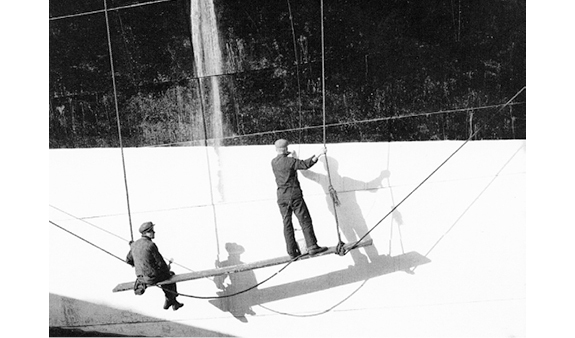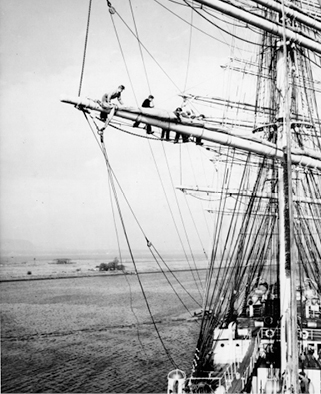
Полная версия
The Last Grain Race
At eight o’clock came breakfast, which was a mess of pungent beans and very pickled bacon. I was then told to collect a hammer, a pot of red lead and a brush and go over the side forward to chip the rust off the topsides – a job the more experienced and favoured members of the crew had been engaged in since 6 a.m. Rain was still falling steadily. There were already two or three precarious platforms over the side when I got there. They were simply planks with ropes made fast to either end and belayed on deck.

Painting the ship
I do not think it was by design that the platform I inherited was in the most difficult position right over the bows, about two feet above the water. Grimly I lowered myself twenty feet to the platform, to find that it was immediately below the lavatory which I had just cleaned. I began to wish that I had used two or three more buckets of water, and this was a good lesson to me in doing a job thoroughly. At sea one was very likely to find oneself let down by one’s own mistakes. I had not the strength to climb the rope again and shift to a more wholesome area, so I settled down to work where I was.
Set perilously above the dirty waters I first chipped and then red-leaded a large irregular piece of the ship’s side, using red lead from the pot which hung in front of me on a cord. Horizontal movement of the platform was controlled by a system of ropes. In trying to move my platform so that I could work in a fresh and more agreeable situation, and being unable to regain the deck to shift the head-ropes, I inadvertently let slip a clove-hitch which was keeping my platform about four feet to the left of its proper position. The whole construction, thus released, swooped sideways and hit the platform of the man who early that same morning had told me to ‘shot op’ when I hit my head on his bed-boards. He was an able seaman called Sedelquist, made more bad-tempered than usual by the events of the previous evening. The shock of the collision made me drop my hammer in the dock, upset the red lead on Sedelquist’s overalls, and knocked the brush out of his hand. It gave him a bad fright. I had not imagined that he could speak English, as up to now we had not spoken, but he immediately called me a ‘focking1 bastard’ and disappeared on deck. Soon he returned with the same Mate who had sent me aloft the day before.
‘What d’you bloody well think you’re doing?’ he shrieked down at me.
‘I’m terribly sorry,’ I replied. This piece of English courtesy was wasted on the Mate. In fact it made him more angry.
‘I’m sorry you’re in this ship. Where’s your hammer?’
‘I’m afraid it’s gone,’ I replied, almost bashfully.
‘Jesus,’ said the Mate. ‘Because you’re English you think you can lose my hammers. I’ll take it off your pay.’
When, months later, I got to Australia and collected part of my pay, amongst the deductions for cigarettes and so on made by the Captain, was my little hammer.
‘You are zorry, I am zorry,’ said Sedelquist, when the Mate had gone, looking at his beautiful dungarees covered with red lead.
My morale, which had been dropping since I arrived in Belfast, fell to new depths. But I was learning. I vowed that I would never again, whilst in the ship, be sorry for anything, and apart from some lapses I managed to keep this resolve. I had been outraged by Sedelquist’s action in rushing on deck to tell the Mate what had happened. Years of school life, happily behind me, told me that by schoolboy standards, Sedelquist had ‘sneaked’. At my prep school he would have been sent to Coventry. Here I seemed to be in danger of suffering the fate which should have been his.
After some hours on the freezing platform, during which I brooded on these questions and hit viciously at the ship’s side, a whistle blew. It was the dinner hour. Sedelquist swarmed up his rope with agility. Pride prevented me from asking his help. I had never been very good at climbing at school and I had always loathed the glib, bouncy, P.T. instructor who used to disport himself on the comfortably thick ropes in the gym. This rope was different. It was two-inch manilla and very greasy. With great efforts I rose seven or eight feet and then slipped miserably down again. My second try took me higher but I could not see how I could climb out over the flared bow.
I managed to get within an inch or two of the lower rung of the rail and then I was back on my platform, almost in tears. I considered jumping in the dock and swimming or shouting to attract attention. Neither of these courses really appealed to me. Eventually I managed to traverse the side of the ship and reach the platform beyond Sedelquist’s. Here I got my foot in a hawse-pipe and reached the deck easily.
Dinner was over and the ‘Little Dutch Mill’ was being played when I arrived. I was greeted with derisive cheers. I had learned another lesson, not to be late for meals.
‘You are zorry,’ said Sedelquist, ‘and you are noh strong.’
There was no reply to this and I got on with the cold remains of the dinner which I had begged from the Cook and which seemed unaccountably good.
Although my popularity was at a low ebb, it received a tremendous fillip the next day, my third on board, a short period which already seemed to me like an eternity. The coal supplies were low and we were replenishing them from the shore. I was therefore rather dirtier than usual and was looking forward to a bath at the Salvation Army Refuge, of which I thought very highly, having had a hot one for next to nothing the night before. I was standing at the rail when I saw a very fast and luxurious sports car nose its way along the dock and come to a halt by the ship. There was a flurry of skirts as the occupant emerged, and a distant vision of legs of timeless elegance as a woman, clutching a splendidly unpractical hat, came up the gang-plank.
Naturally all work on board ceased, and the crew gave themselves up to an orgy of speculation. There was a short interval before she appeared by the mainmast, escorted by two Mates (the First having just joined); both wore social expressions and braid caps which they had put on with miraculous speed. According to Sedelquist, they kept their hats handy in the officers’ lavatory for just such an emergency. I was not used to the Second Mate in this new social role, but by now I had recognised the visitor and was not as surprised as the rest of the crew when I was called aft.
The visitor was a great friend of my parents, called Lucy, whom I had always worshipped from afar. Whenever possible I would refer to her as ‘my aunt in Ireland’, but it was only practicable to do so when she was not present and to people who did not know her. I had been debarred from any other pretence by my extreme youth. Now, here she was, dressed in black, the most elegant woman in Ireland. I must have looked pretty bad, because her first words were: ‘Och, Eric, come away home now, your mother’s crying her eyes out.’
‘I’m afraid I can’t, Lucy,’ I said, lying bravely. ‘It’s tremendous fun really, and I’m not always as dirty as this.’
‘Can he come home with me?’ she asked the Mate, who was goggling.
‘We stop work at twelve o’clock on Saturday. He must be on board by six o’clock on Monday morning.’ I really thought that he was going to choke as the words came dragging out of his boots.
‘How sweet of you,’ said Lucy, going over him with a lovely smile. ‘I’ll pick him up here. Now, can he please show me the ship?’
I didn’t think that even Lucy could pull this one off but she did, inserting a parenthetic: ‘Perhaps you could come too. I am sure Eric knows very little about it.’
Both Mates escorted her to the car when she drove away. It may have been autumn in the York Dock, but over the deck of the Moshulu hung the expensive scent of springtime.
The boys crowded round. Just like school again.
It was Sedelquist who led the interrogation.
‘Who is hee?’
‘She’s called Lucy.’
‘Hee is very good. Hee is your friend?’
‘She’s all right,’ I parried.
Sedelquist persisted: ‘Hee is your girl friend.’ I pondered this, wondering why he had not said boy friend. I thought too of my diminished status, all the mistakes I had made in three short days: If we did not sail soon I should be a laughing-stock.
Sedelquist was about to ask the same question again.
‘Hee …’
‘Well, sort of,’ I said. ‘She’s a sort of aunt.’
Whatever the Scandinavian interpretation of ‘aunt’, it satisfied everybody. I was ‘noh strong’, but Lucy was my aunt and in the dark days to come, before I became ‘you strongbody’ and could take it out of other people, it was the respect that the crew had for her that kept the mass of them on my side whatever violent battles I might have to fight individually.
6
Sömmarström and his Sails
On Monday morning I was delighted to find that two more ‘foreigners’ had arrived on board and had been allotted to the starboard fo’c’sle. One of them, George White, was a tall thin young man from Massachusetts; the other was a young Dutchman called Jack Kroner who spoke fluent English. Both had signed on as apprentices, but Jack, who had been to sea before, had very sensibly evaded the premium which my father had been required to pay on my behalf, by arriving unheralded at the ship and striking a bargain on the spot.
Belfast after dark, into which we used to sally with Vytautas on modest porter-drinking expeditions, was a strange city, like a studio set for a Hitchcock thriller and equally deserted. The rain shone on the cobblestones and the wind howled down the dismal thoroughfares, rattling the glasses of the gas-lamps above our heads.
The only people we ever encountered off the main streets were numbers of apparently able-bodied men who would emerge from the shadows outside public houses and demand money. If not satisfied they would become abusive. One of the Finns who was being repatriated became so enraged by their attentions that he picked one of them up and threw him bodily into a glass shopfront. His departure was delayed for some days by this act, but he was saved from serious consequences by his ignorance of English and the ingenious plea put forward on his behalf that he had misunderstood the nature of the importunity. The four of us never had any compunction about refusing these requests for money as we had so little ourselves.
During these innocuous evenings spent in the snug of one of the less wild pubs we gradually drew up, to use the idiom of the times, a multi-lateral pact to resist those Finns and Swedes who already showed signs of becoming aggressive. Vytautas was not included in these arrangements. He had already made a round voyage in Moshulu and his position was established; besides, he had the happy temperament that did not attract trouble. Like other pacts in the world outside, to which we gave so little heed, it was to be rendered invalid by the loss of one of the contracting parties and the isolation of the remaining two, which made it impossible for one to help the other.
For the most part our thoughts were dominated by The Voyage. Sometimes, tired of the squalor in which we found ourselves, it seemed that we would never sail. It was Vytautas, by far the most resilient, who made us feel, by some reminiscence of life in the Trade Winds or in the high latitudes, that our present discomforts were bearable.
The last of the cargo was unloaded and the ship was warped down the dock to a deserted quay where we were to take on board our ballast stiffening for the voyage to Australia. There we cleared hundreds of blind baby mice from the frames in the hold; cleaned out the bilges which were filled with rotting grain and very smelly bilge-water, and set to work sweeping out the ’tween-decks. It was here that the accident occurred. The weather had been abominable and the open hatches were covered loosely with tarpaulins. In the ’tween-decks it was pitch black. We had two lanterns, and by the light of one of these George was sweeping with a will, working his way aft. Soon he was outside the circle of light thrown by his lamp; unused to the ’tween-decks, he stepped backwards over the tonnage opening below No 3 hatch and fell into the empty hold, hitting the keelson twenty feet below. When we reached him he was rigid, but still breathing. By the time we had got him out of the hold on a stretcher he was conscious and in pain. In the ambulance on the way to hospital he said. ‘I guess you’re going to have to do without me.’
One of his legs was broken and quite a lot of other things as well. He remained in hospital until December, two months after we sailed. It was a bitter disappointment for George; unlike the American of European imagination, he was not a rich young man. He had worked his passage to England and spent most of his savings to realise his ambition. I was downcast too. I had been long enough in the ship to realise that the confined space in which we lived would become very irksome once we were at sea. I was now deprived of my principal ally.
The following day Vytautas fell off the donkey house and broke an arm. Moshulu was dangerous for the unwary.
At the quay we took in our ballast, fifteen hundred tons of coarse dark sand used in the manufacture of pig-iron, huge lumps of paving-stone, granite blocks, and the best part of a small house. At the same time the stevedores added two dead dogs, but we did not discover this until we reached Australia in January, the hottest month of the year.
John Sömmarström, Sailmaker and Bosun of Moshulu, was a famous figure in the Erikson ships. If ever a man deserved the title of ‘shellback’ it was he.

John Sömmarström, Sailmaker
When I first met him he was fifty-eight years old and had been forty-three years at sea, all of them in sail, most of them in square rig. He had served in Scottish ships like Loch Vennachar in the 1900s and he had been for a time in the china-clay trade between Par in Cornwall and other West of England ports. In later years he had been Sailmaker in the barquentine Mozart which he described as ‘a cow’, the four-masted barque L’Avenir (he had served four years in L’Avenir when Erikson still had her), and a year in the Archibald Russell.
As I entered the sail loft I had an impression of a solid chunky man with spectacles set on a rather snub nose and a face covered with grey stubble. He was sitting in his shirt sleeves reading The Seven Pillars of Wisdom. In his mouth was a pipe that had gone out and on his head a unique hat. It was an ordinary grey felt hat, tweeked up in the middle like a scoutmaster’s, punctured with a number of holes that might have been made by bullets, intended, he said, to allow the air to circulate. I noticed that his fingers were rather stubby but that the nails were very finely formed. He had a wonderful smell about him compounded of hemp and Stockholm tar.
When he began to speak I was surprised that he spoke really fluent English, or rather Scots, with the accent of the Clyde. Perhaps he had picked it up in the Loch Vennachar. I told him what I wanted.
‘It’s a funny thing that most of the people who get killed in these ships are Englishmen,’ he granted. ‘Limeys we used to call them. There were Limeys, Squareheads, and Dagoes. You’re a Limey. You hang on tight.’
(Readers who are discouraged by technical details about sails and sailmaking should skip the rest of this chapter.)
‘If you like,’ he went on, ‘I’ll tell you something about square sails. First, they’re not square at all, they’re four-sided and square at the head but the foot’s cut on an arc, called the roach, to allow the sails to clear the fore-and-aft stays when they’re set.
‘Most people seem to think that a sail’s cut in one piece. A sail’s cut cloth by cloth. I already know how wide the sail has to be because all square sails extend to within eighteen inches of the yardarm cleats on the head, and the depth depends on the height of the mast and the distance between the yards.
‘That’s the material over there.’ He pointed his pipe at a heavy bolt of canvas. ‘Webster’s 24˝ Standard Flax Canvas from Arbroath. The finest stuff in the world and expensive.’
‘How much would it cost to make a complete new set for the ship?’
He glared at me. ‘About £2,500. But you listen to me. It doesn’t matter to you, does it, how much it costs? I’m telling you something more important.’ His pipe had gone out so I offered him some tobacco, rather diffidently, afraid that Fribourg and Treyers’s mixture would not be strong enough for him. It made him splutter a bit at first but he appeared mollified. ‘Where was I?’ he said. Fortunately this was a purely rhetorical question and did not require an answer from me.
‘I said that a sail is cut cloth by cloth and before I start the actual cutting I have to calculate the number of cloths the width requires, allowing for seams, tabling on the leeches and slack. The leeches are the perpendicular edges, and you have to allow some slack when sewing on the bolt ropes, otherwise when the bolt rope stretches in wear, the sail might split.’
‘What is tabling?’
‘Tabling is a broad hem made on the skirt of the sail by turning the edge and sewing it down. It strengthens the sail for sewing on the bolt rope. You needn’t be afraid to ask if you don’t understand. I only get wild if you ask me questions like a bloody fool reporter.’
He continued: ‘In the depth I’ve got to allow for tabling at the head and the foot. There are gores in a sail too, they’re the angles cut at the ends of the cloth to increase the width or the depth. The canvas for the gores is cut on the cross, the longest gored side of one cloth makes the shortest side of the next. After the first gore is cut the rest are cut by it.’
‘Christ,’ I muttered, overcome by the Sailmaker’s command of technical and outmoded English with which he seemed equally at home as with his native Swedish. He began to explain how he found the number of yards of canvas needed. ‘It comes in bolts twenty-four inches wide. I add the number of cloths in the head and the foot together and halve them to make them square. Then I multiply the number of squared cloths by the depth of the sail and add to that the additional canvas contained in the foot gores, and linings and the four buntline cloths. The linings are sewn to the leeches and middle to strengthen it. The buntline cloths are to stop chafing on the sail. That’s why the sails are heavy. A course, that’s the big sail on the fore, main and mizzen – weighs more than a ton, and much more when it’s wet.
‘If you’re interested,’ went on the Sailmaker, ‘I’ll tell you something about sailmaking. This is my sail-loft.’ He waved his hand to indicate the austere and cramped quarters in which he worked. ‘And these are my tools: palm and needles; a sail-hook.’ He held up a small iron hook with a cord spliced to an eye in the shank. ‘Used for holding still the work. Marline-spikes for opening rope strands when I splice. A wooden fid for the same purpose. A pinker, like a marline-spike but straight, and a heaving-mallet.’ This was a hammer with a small cylindrical head used as a lever to haul tight the cross-stitches when sewing the bolt ropes on the sail.
‘What are the bolt ropes?’ I asked, having wanted to know all this time.
‘The bolt rope is sewn to the edge of a sail to stop it splitting. It’s either wire or hemp, mostly wire now. If it’s hemp it’s sewn with three-thread twine. The rope has to be well twisted while this is being done and it has to be cross-stitched on the leeches every twelve inches on every seam and at the middle of every cloth in the foot. In the head of the sail are the cringles through which the rope-yarns are passed securing the sail to the jackstay on the yard. In the foot are the cringles to which the buntlines are fastened and by which the sail is drawn up to the yard for furling.’
‘And what’s this?’ I asked him, holding up another hammer with a grooved head. ‘Another sort of heaving-mallet?’
‘It’s a serving-mallet,’ he replied. ‘And this is the way I serve a clew – which, by the way, is the lower corner of a sail to which the sheet is fastened.’
On the leech of the sail was a cringle, a ring made by working a strand of rope round an iron thimble. This cringle he hooked on to a bulkhead, hung off a block and tackle on the bolt rope where the clew was to be and set it up taut between a vertical iron post and the bulkhead. He took a ball of spunyarn, made two or three turns round the bolt rope, confining the end under the turns; he placed the serving-mallet on the rope, passing the yarn round the rope, the head of the mallet and the handle. ‘Take hold of this,’ he ordered, handing me the ball of yarn to pass round the rope as he turned the hammer which wound the yarn tightly on to the rope.
‘This is serving,’ said the Sailmaker, after he had made a few turns to show me the idea, ‘but first you must worm the rope by winding spun yarn along the contour of it to get a level surface and after that you parcel it with tarred canvas wrapped on before you serve it.
‘Now that you know how to make a sail,’ the Sailmaker went on optimistically, ‘you must know how to sail the ship. Do you know anything at all about square rig?’
I said that I knew very little.
‘Huh,’ he sniffed contemptuously. ‘Well, you’d better bloody well wake up and learn.’
He immediately launched into a long and clear exposition of the theory of square sails and the action of the water on the ship’s rudder. How, when Moshulu’s wheel was put to starboard, the rudder would go to starboard and the vessel turn to starboard; that the greater the angle of the rudder the more the ship’s way would be impeded. It was therefore important so to balance the ship with sails that only a slight touch on the helm was necessary.
‘Now suppose,’ said the Sailmaker, ‘that Moshulu has the wind on her starboard beam, that is to say at right angles to the direction in which she is heading. Sails are set on the foremast only and the yards are braced so that the sails are full. What happens? I’ll tell you,’ he said before I could open my mouth. ‘Her bows will fall off and her stern will come into the wind. That’s because she rotates on her pivotal turning point, which is forward of the mainmast when she’s trimmed properly. With sail set on the mizzen, her head will come into the wind. With sail on the main only she will go ahead, and if the yards are braced so that the wind blows on the forepart of the square sails, she’ll go astern.’
He went on for an hour and I only understood half of what he told me. Finally he lumbered to his feet, saying: ‘I’m off to see the Consul. Leave that list of English words, I’ll write down the Swedish later.’
Now he was getting restive, rummaging in a box. ‘Aw hell, I’ve got to see the Consul.’
‘Which Consul?’ I asked, wondering why he suddenly wanted one at five o’clock on a wet October night.
‘The one under the fo’c’sle head, on the port side,’ he grunted triumphantly, for he had just found a copy of the New Statesman and Nation to serve his need, and departed on this urgent mission.

Preparing sails for the Atlantic
The next morning, in spite of consultations between the Mates and the Sailmaker the utmost confusion prevailed. For winter in the North Atlantic we needed a complete suit of thirty-one storm-sails. Some of them were in the sail-loft but the rest were in the ’tween-decks mixed up with tropical sails we would need later and old blown-out rags too rotten to mend. None of the crew seemed to know which sails were wanted or where they were to be found. The sails were three and four deep in the darkness and as heavy and intractable as lead. The Mates flashed electric torches and groped for the lower leeches of the square sails on which were stencilled the name of the sail, together with the initials of the maker. There were some very old sails amongst the newer ones. One or two, of American cotton, must have been made for her before she was laid up in Seattle after the 1927 voyage to Melbourne; others were out of a well-known ship, the Star of England. There was also a mainsail with reef-points in it from Herzogin Cecilie, which must have been made before 1921 when she passed to the Finns, and was probably made long before 1914, at the time when she was a training-ship and cargo-carrier for the Norddeutscher Lloyd Company.








